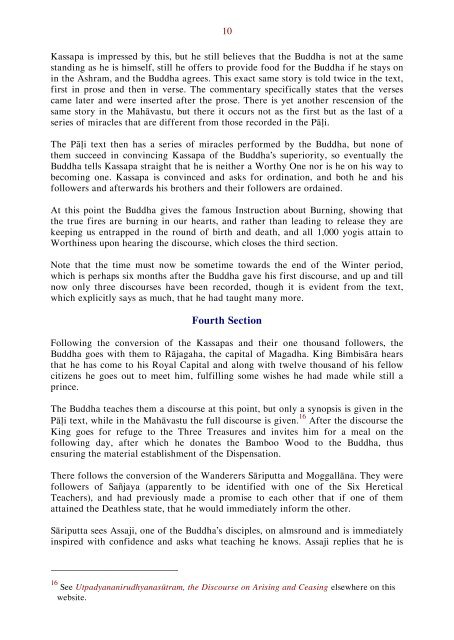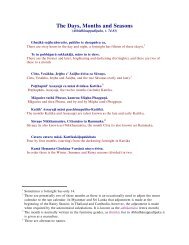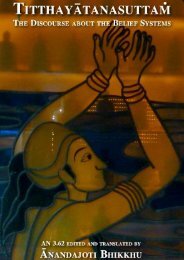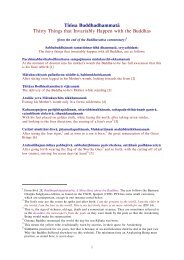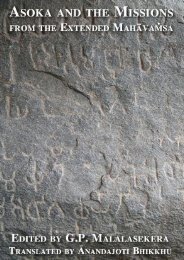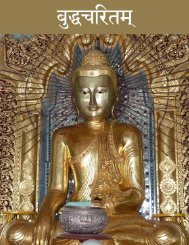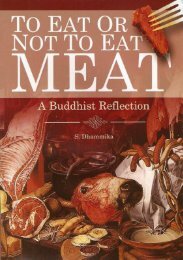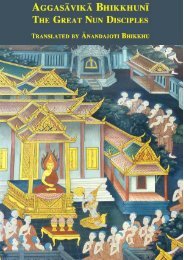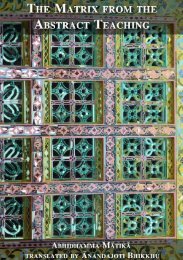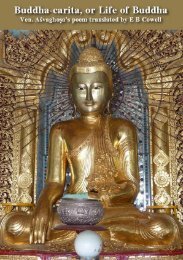MahÄkhandhako The Great Chapter - Ancient Buddhist Texts
MahÄkhandhako The Great Chapter - Ancient Buddhist Texts
MahÄkhandhako The Great Chapter - Ancient Buddhist Texts
You also want an ePaper? Increase the reach of your titles
YUMPU automatically turns print PDFs into web optimized ePapers that Google loves.
10<br />
Kassapa is impressed by this, but he still believes that the Buddha is not at the same<br />
standing as he is himself, still he offers to provide food for the Buddha if he stays on<br />
in the Ashram, and the Buddha agrees. This exact same story is told twice in the text,<br />
first in prose and then in verse. <strong>The</strong> commentary specifically states that the verses<br />
came later and were inserted after the prose. <strong>The</strong>re is yet another rescension of the<br />
same story in the Mahāvastu, but there it occurs not as the first but as the last of a<br />
series of miracles that are different from those recorded in the Pāḷi.<br />
<strong>The</strong> Pāḷi text then has a series of miracles performed by the Buddha, but none of<br />
them succeed in convincing Kassapa of the Buddha’s superiority, so eventually the<br />
Buddha tells Kassapa straight that he is neither a Worthy One nor is he on his way to<br />
becoming one. Kassapa is convinced and asks for ordination, and both he and his<br />
followers and afterwards his brothers and their followers are ordained.<br />
At this point the Buddha gives the famous Instruction about Burning, showing that<br />
the true fires are burning in our hearts, and rather than leading to release they are<br />
keeping us entrapped in the round of birth and death, and all 1,000 yogis attain to<br />
Worthiness upon hearing the discourse, which closes the third section.<br />
Note that the time must now be sometime towards the end of the Winter period,<br />
which is perhaps six months after the Buddha gave his first discourse, and up and till<br />
now only three discourses have been recorded, though it is evident from the text,<br />
which explicitly says as much, that he had taught many more.<br />
Fourth Section<br />
Following the conversion of the Kassapas and their one thousand followers, the<br />
Buddha goes with them to Rājagaha, the capital of Magadha. King Bimbisāra hears<br />
that he has come to his Royal Capital and along with twelve thousand of his fellow<br />
citizens he goes out to meet him, fulfilling some wishes he had made while still a<br />
prince.<br />
<strong>The</strong> Buddha teaches them a discourse at this point, but only a synopsis is given in the<br />
Pāḷi text, while in the Mahāvastu the full discourse is given. 16 After the discourse the<br />
King goes for refuge to the Three Treasures and invites him for a meal on the<br />
following day, after which he donates the Bamboo Wood to the Buddha, thus<br />
ensuring the material establishment of the Dispensation.<br />
<strong>The</strong>re follows the conversion of the Wanderers Sāriputta and Moggallāna. <strong>The</strong>y were<br />
followers of Sañjaya (apparently to be identified with one of the Six Heretical<br />
Teachers), and had previously made a promise to each other that if one of them<br />
attained the Deathless state, that he would immediately inform the other.<br />
Sāriputta sees Assaji, one of the Buddha’s disciples, on almsround and is immediately<br />
inspired with confidence and asks what teaching he knows. Assaji replies that he is<br />
16 See Utpadyananirudhyanasūtram, the Discourse on Arising and Ceasing elsewhere on this<br />
website.


